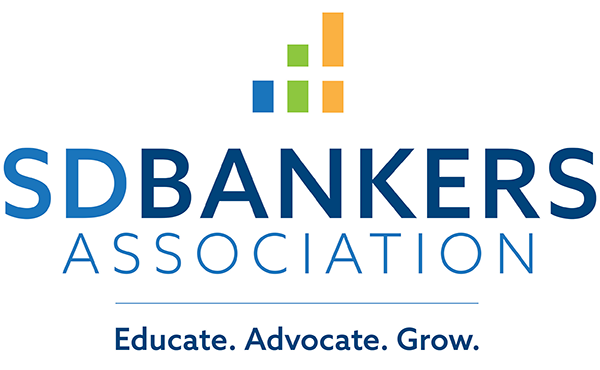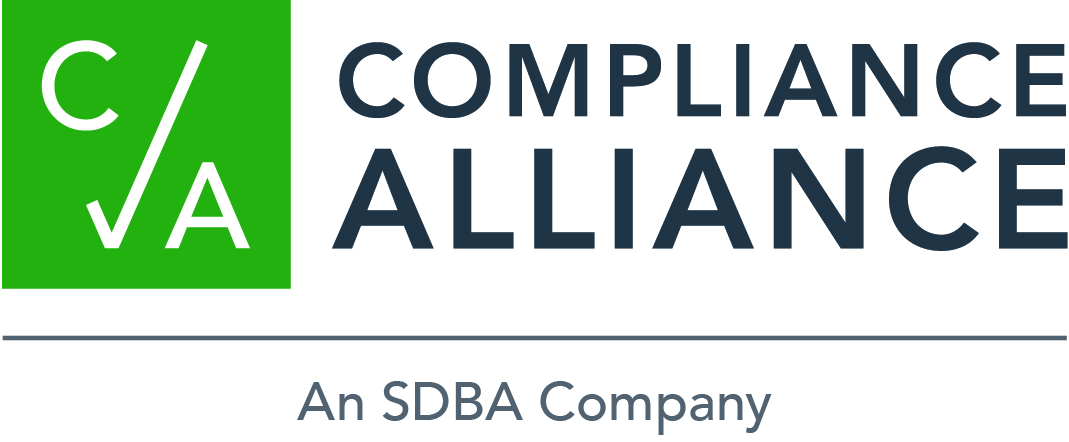- Education & Events
- Advocacy
- Products & Services
- Membership
- Resources
- SDBANKER Magazine
- SDBA eNews
- SDBA eNews Archives
- Legislative Update/Bill Watch
- South Dakota Bank Directory
- Women in Banking
- Scenes of South Dakota Calendar*
- Holiday Signs
- Regulatory Report
- South Dakota Banking Code
- Record Retention Manual
- Advertising & Sponsorship Guide
- COVID-19 Resources
- Mental Health and Crisis Prevention
- About
|
Registration Open for SDBA 2020 Ag Credit Conference
This conference focuses on the unique needs of ag bankers and the need for quality information and training to better serve their customers. The SDBA has lined up speakers on a variety of timely topics to help ag bankers navigate through challenging times. Experienced and new ag lenders, as well as CEOs, will all benefit from this conference. Sessions at this year's conference include a commodity outlook and how it impacts the ag economy, a Washington update from the ABA's Ed Elfmann and Sen. Mike Rounds, a panel of young and experienced ag bankers and their customers, and sessions on weather risk and production agriculture and proper loan structuring. Bret Afdahl Named to FDIC Advisory Committee of State Regulators
The Advisory Committee is intended to facilitate regular discussion of safety and soundness and consumer protection issues, the creation of new banks, the protection of the nation's financial system from risks such as cyber-attacks or money laundering, and other timely issues. “I fully intend to use this forum to continue discussions and to search for solutions to the challenges of small, rural communities maintaining full access to local banking services,” said Afdahl. “Anything we can do to keep community banks in our small communities will benefit the citizens of South Dakota and our country.” Committee members include regulators of state-chartered financial institutions from across the United States as well as other individuals with expertise in the regulation of state-chartered financial institutions. See the full list of committee members.
FHFA Seeks Views on FHLB Membership RequirementsAs expected, the Federal Housing Finance Agency on Monday issued a request for input on Federal Home Loan Bank membership. Specifically, the agency is seeking comments on the eligibility requirements for FHLB membership—including the financial condition requirements—as well as feedback on how any potential changes to these requirements would affect the system’s safety, soundness and overall mission. Comments on the RFI are due in 120 days and will be used to inform any potential rulemaking FHFA may deem appropriate. ABA welcomed the FHFA’s efforts to ensure the safety and soundness of the FHLB system and allow adequate time for the industry to provide feedback. The association is currently reviewing the proposal and will provide a detailed comment letter. As ABA has noted in previous comments, its principal concern remains protecting the capital investments of its member institutions—who are the owners of the FHLB system—and ensuring that the system remains a reliable funding source for members of all sizes. Read the RFI. For more information, or to join ABA’s comment letter working group, contact ABA’s Joe Pigg. ABA Launches Ads Calling for End to Large CU Tax ExemptionAs part of its ongoing efforts to educate policymakers and the public about large credit unions’ abuse of their tax exemption, ABA—through its Explore Credit Unions campaign—is launching a new series of ads designed to highlight how large credit unions have lost their way. The ads will appear in Politico’s widely read Morning Money newsletter and on digital and social media platforms. The campaign coincides with the arrival of credit union executives on Capitol Hill for the Credit Union National Association’s governmental affairs conference this week. The ads highlight several ways that large credit unions have far exceeded their statutory mission to serve individuals of modest means—from buying up taxpaying banks to purchasing naming rates to sports stadiums. They also call for a reexamination of the tax exemptions for these institutions. In addition to the advertising campaign, ExploreCreditUnions.com will feature new blog posts that highlight the ways credit unions have outgrown their special treatment. New Industry-Led Data Sharing Network to Offer Greater Security of Consumer DataTogether with 11 of the nation’s largest banks, the Clearing House and Fidelity Investments last week announced a new data-sharing network intended to give consumers greater control over how their financial data is shared with third-party providers. The network will be operated by Akoya, a company previously owned by Fidelity, which has been spun off as an independent entity and is now owned jointly by those organizations. Access to the network will be open to the entire financial industry, including banks of all sizes. Akoya’s secure application programming interface-based network effectively acts as a bridge between financial institutions and third-party data recipients, allowing data to be transferred in a safer, more transparent way than current methods like screen-scraping, which require third parties to retain bank customers’ login credentials to display account information. “This is a major step forward in giving consumers control of their data and allowing them to share that data securely with third-party applications they want to use,” said Michael Corbat, CEO of Citigroup and chairman of the Clearing House. “Data security is a top priority for the industry, and bringing Akoya together with the Clearing House and its members will meaningfully advance the availability of a secure data sharing ecosystem while preserving customer choice.” Read more. For more information, contact ABA's Rob Morgan. Podcast: How a Community Banker Helped a City Discover Modern ArchitectureWith just 44,000 residents, how did the town of Columbus, Ind., become one of the nation’s leading architectural destinations—ranked sixth of all U.S. cities for architectural innovation and design by the American Institute of Architects? The answer: a community bank president named J. Irwin Miller. On the latest episode of the ABA Banking Journal Podcast, sponsored by Franklin Madison, historian and biographer Nancy Kriplen shares the story of how Miller—the head of both the family-owned Irwin Union Bank and the Fortune 500 diesel engine manufacturer Cummins—revitalized Columbus in the 20th century by recruiting some of the world’s most accomplished modern architects to design buildings there. Architects with credits in Columbus include Eliel Saarinen and his son Eero, Harry Weese, Cesar Pelli, Robert Venturi, I.M. Pei, Kevin Roche and Robert A.M. Stern. Kriplen discusses Miller’s role in hiring Eero Saarinen—best known for buildings like the Gateway Arch and the Dulles International Airport terminal—to design the Irwin Union Bank headquarters in 1954, which is considered one of the earliest open-concept bank buildings. She also speaks to his commitment as a community banker to local ownership and investment. Listen to this episode.
Marketing ICS and CDARS to South Dakota Public FundsSo your bank is ready to go to market to public funds managers with ICS, the Insured Cash Sweep® service, and CDARS. Now what? Promontory Interfinancial Network has worked with thousands of banks that use ICS and CDARS to offer customers access to multi-million-dollar FDIC insurance; to attract high-dollar, relationship-based deposits; and to grow profitability. Based on more than 15 years of listening to banker experiences, Promontory has created a new resource for Promontory Network members designed to illustrate the most successful practices of banks that use ICS and CDARS. Promontory is offering a free webinar "Driving ICS and CDARS Success" on March 17 at 2 p.m. CST and March 19 at 10 a.m. CST. This webinar will cover strategies used by banks to maximize adoption of the services as well as the materials and resources available to your bank to do so. American Elder Abuse Conference Seeks SupportThe American Elder Abuse Conference set for May 4-6 in Slidell, La., is a unique opportunity to identify ways to more effectively protect elderly citizens. The conference provides nationally-approved continuing education for several licensed professions, including bankers. Conference faculty includes financial services professionals, prosecutors, forensic experts, medical professionals, law enforcement personnel and a variety of other disciplines that offer insightful information for professionals at the line, supervisory, management and administrative levels. A wide variety of topics will be covered including ethics, federal agency cooperation, mandatory reporting, financial exploitation, mental capacity screening and assessment, impaired decision making, sexual abuse, physical abuse and neglect, pharmaceutical issues that impact cognition, abuse/misuse of powers of attorney and fiduciary authority, dementia, and educating the public. Conference organizers are currently seeking sponsors to help fund the event and send staff to attend for training. Learn more. Questions, contact conference director Ralph Oneal.
|


 Registration is now open for the SDBA's 2020 Agricultural Credit Conference set for April 15-17 at the Ramkota Hotel & Conference Center in Pierre.
Registration is now open for the SDBA's 2020 Agricultural Credit Conference set for April 15-17 at the Ramkota Hotel & Conference Center in Pierre.  Bret Afdahl, director of the South Dakota Division of Banking, has been named to the FDIC's
Bret Afdahl, director of the South Dakota Division of Banking, has been named to the FDIC's 